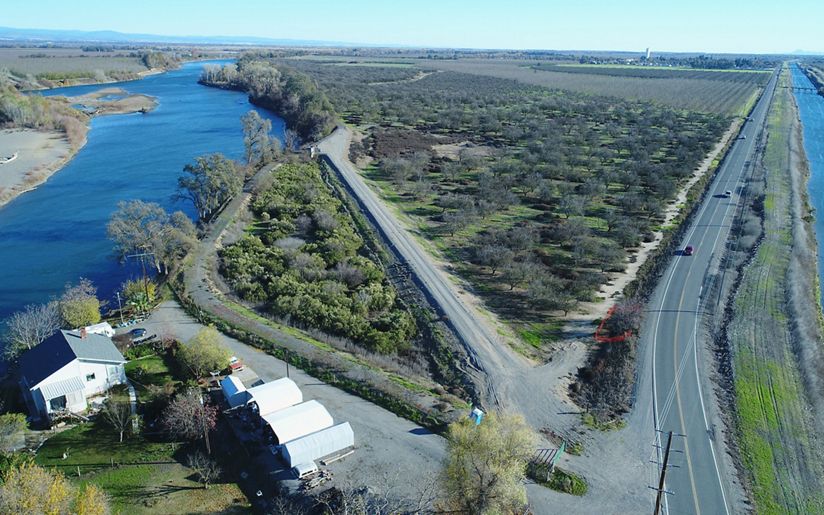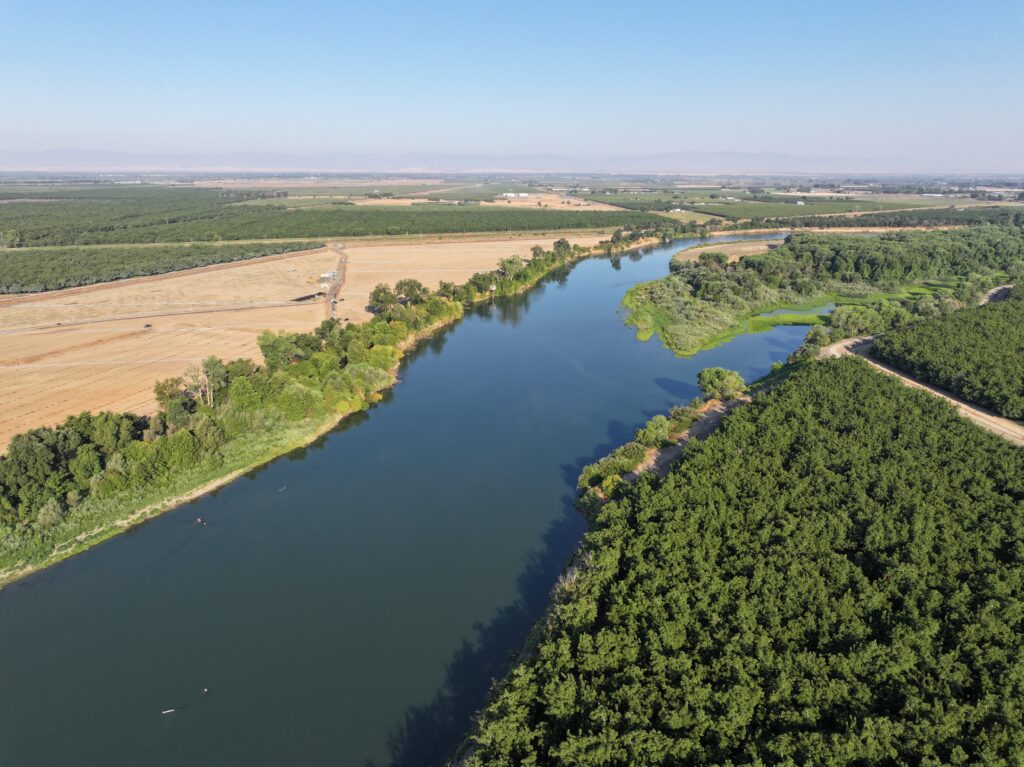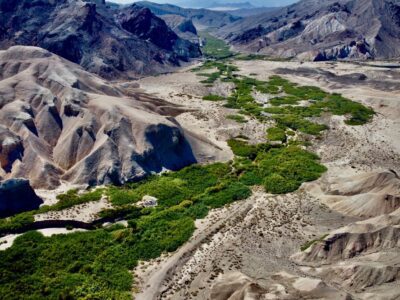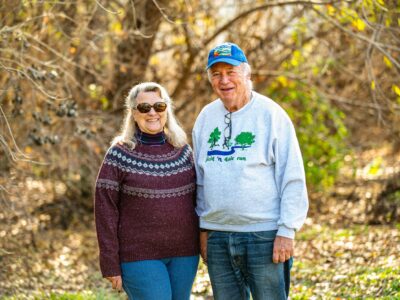With a population approaching 2,200, the town of Hamilton City has one four-way traffic light at the corner of its one high school, a railroad crossing on the east side of town, and acres and acres of agriculture, its main industry. It’s a town that people drive through on their way to or from Interstate 5. And the Sacramento River, California’s largest waterway, flows near the town.
This river provides water for agriculture, a rich and complex habitat for river life, and recreational opportunities for residents and visitors. However, during seasonal rains and high-water events, it’s prone to flooding Hamilton City—located within a historic floodplain. Its residents have had to evacuate the town six times over the last 30 years.
In 1904, a levee was built to protect the town (and a new sugar factory) from flooding when the Sacramento River swelled. But over the decades, repeated flooding, erosion, and time had all weakened the levee, leaving it unreliable in keeping water out of Hamilton City.
River Partners Field Foreman Chris Carrizales, a lifelong Hamilton City resident, experienced each evacuation—and every time was as upsetting as the last.
“Over the last 30 years, watching the weather forecast, preparing to leave when the heavy rains come, and packing our belongings, we know how to prepare for it,” Carrizales said. “This community is resilient, cooperative, and we work together to make sure we’re all safe. But there’s always the nagging feeling that this will be the one that does something Hamilton City won’t be able to bounce back from.”
River Partners recently completed the second and final habitat restoration phase of the innovative Hamilton City Flood Risk Reduction and Ecosystem Restoration Project, which includes a modern levee setback up to nearly a mile wide at its largest point. By being positioned farther away from the Sacramento River, more of the historic floodplain will be able to absorb floodwaters, which recharges groundwater stores and reduces erosion on the levee and riverbanks. This also gives the community enhanced flood protection, while also restoring critical habitat for endangered salmon, mammals, and birds, by planting thousands of native plants and vegetation and restoring the historic floodplain.

Conducted in partnership with The Nature Conservancy; California Department of Water Resources; Reclamation District 2140; Paris Kincaid Wasiewski LLP; and Larsen, Wurzel, and Associates, this was the first project in U.S. Army Corps of Engineers (USACE) history to use ecosystem restoration and wildlife benefits to offset flood-risk engineering and management costs. It serves as a model for additional federally funded flood protection and habitat restoration projects throughout the state and across the nation.
In 2016, River Partners began work on the first phase of restoration, which was completed in 2019, planting riparian forest, scrub, oak savanna, and grassland habitats. Additionally, in 2016, the USACE began construction of 6.8-mile setback levee. That project was completed in 2017.
The new levee will provide enhanced flood protection for Hamilton City and significantly reduce the risk of damage to property, crops and livelihoods. Additional restoration benefits from the levee construction will support populations of dozens of imperiled wildlife species, including endangered salmon, along the Sacramento River.
For the final phase of project, completed in July, River Partners restored nearly 465 acres of former farm fields along the banks of the Sacramento with 67,000 native trees and plants. River Partners will continue irrigating and monitoring the restored riverway forests for three years, after which irrigation will be turned off and nature will take over.
The total cost for both phases was $81.7 million and is the first project in USACE history that used ecosystem restoration and wildlife benefits to offset flood-risk management costs. Project partners which helped coordinate and secure funding, land, and other resources to construct the new levee include:
- The California Department of Water Resources funded a significant portion of Phase 1 restoration and $4.7 million in Phase 2 restoration
- The USACE constructed the new Hamilton City setback levee, funded 65% of the construction costs, and is the federal project sponsor
- Reclamation District 2140 secured its remaining 35% share of project costs through grants from the State of California, including the California Department of Water Resources and California Wildlife Conservation Board, and donations from The Nature Conservancy
- The Nature Conservancy oversaw federal appropriations to fund the project, developed the restoration plans, managed the project’s real estate needs on behalf of the community, and donated land to complete the project
David Pesavento, Supervising Engineer with the California Department of Water Resources, said that flood risk reduction efforts, including levee setback projects, are often large projects that require extensive resources and coordination, underscoring the unique public-private collaboration needed to undertake the project.
“As a result of these entities working together and utilizing our various strengths and skills, the Hamilton City project has been successfully completed,” Pesavento said. “This effort means not only flood risk reduction benefits for the local community but also ecosystem restoration opportunities created through the setback.”
So, why is the Hamilton City project unique? Located near the 3,900-acre Upper Sacramento River State Wildlife Area and the 10,000-plus-acre Sacramento River National Wildlife Refuge, the project site supported orchard crops for over 100 years.

Ryan Luster, an ecologist for The Nature Conservancy and lead on the Hamilton City project, said up until almost 25 years ago, whether a flood risk reduction project was approved or not came strictly down to dollars spent versus dollars saved.
“You have to show that with every dollar the federal government spends [on flood risk reduction projects], there’s at least one dollar in savings from flood risk reduction,” he said. “In other words, what’s the dollar value that this project is going to save from avoided flood risk damages?”
That was a problem, Luster said, because it prevented places like Hamilton City from being federally funded since the cost of the project far outweighed what was going to be protected.
Hamilton City is a small, rural town, its geography spans less than one-third of a square mile, and its traditionally underrepresented community depends heavily on agriculture. Its century-old levee had severely degraded, and as the community grew and agriculture expanded through the 20th century, groundwater was depleted and filled with chemical runoff. During this time, riparian habitat was also lost, impacting everything from songbirds and salmon.
Following a formula for ecosystem restoration and flood risk reduction, the USACE’s calculations didn’t pencil out to perform this kind of work in Hamilton City. As James Lee, a USACE project engineer, explained in a story originally published by the Chico Enterprise-Record in July, a project needs to prevent more flood damage than it costs to implement.
“For rural communities where damages aren’t as high (relative to cost), it’s very, very difficult to provide levee projects to address flood needs in those areas,” said Lee. “We don’t calculate dollar amounts of ecosystem benefits, but we do try to use models of habitat that would be able to quantify habitat benefits.”
When it seemed Hamilton City’s plight wouldn’t rise to the level of a federally approved ecosystem restoration project, in 2000 Congress changed its stance and approved including ecosystem benefits in its benefit-to-cost ratio calculations for this work. Suddenly, the Hamilton City project was on the table—a portion of the cost of building the levee was attributed to ecosystem restoration.
“When Congress said you can now monetize ecosystem benefits and add that to the avoided damages you’ll be avoiding through the flood risk reduction measures, it was a game changer,” Luster said. “Now we could say that not only do we have at least one dollar in benefits for every dollar that will be spent, but we have far more than a dollar in benefits.”
River Partners Field Manager Josh Waddell is grateful to have been part of the Hamilton City project and is excited to see how the native trees and vegetation planted live in concert with the surrounding community.
“Hamilton City will see and feel the future benefits of this project—flood safety, cleaner water, and more wildlife that once lived here returning to this site,” Waddel said. “All around the state, at our restoration projects, we’re seeing nature taking over and returning to what it once was, a more balanced ecosystem—and that’s a satisfying feeling.”
With the work complete at Hamilton City, nature is settling in nicely.
Families of quail skitter across the dirt. Adult and juvenile wild turkeys cluster together, scraping and foraging, next to the riverside forest. And shadows from the oak trees lining the Sacramento River stretch across the rows of native trees and vegetation—from cottonwood, valley oak, and Pacific willow to slender sage, hoary nettle, and pipevine.
This is the beginning of what River Partners envisions as an example of what river restoration and flood risk reduction projects can look like in places like Hamilton City, supported by public-private partnerships. Luster said he would like to see more projects like this happen around California.
“There need to be more success stories like Hamilton City, and we wanted to show the U.S. Army Corps of Engineers, the Department of Water Resources, and anybody else in the flood risk reduction and ecosystem restoration community an example of what’s possible,” Luster said.








